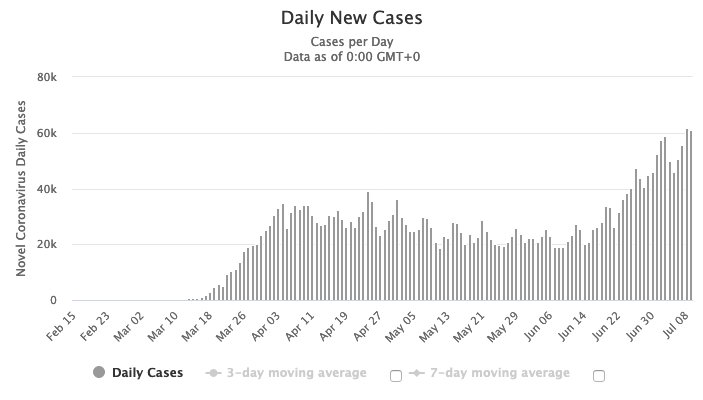Avalanche
July 10, 2020

How bad could it get? For the United States, it seems there is no bottom.
Back in March, I wrote that the nation’s response to the coronavirus pandemic would likely shape its economic, political, and geopolitical fortunes for years or decades to come. Four months later, it’s time for a check-in. How’s that pandemic response going?
Not so well, it seems. The US has the world’s highest number of cases and deaths overall. And of the world’s 25 worst hotspots for transmission, in terms of new cases per day per million of population, 15 are US states.
Early success at “flattening the curve” of the graph of new cases reported daily was followed by a re-opening of the economy that was premature (i.e., before sufficient capacity for testing and contact tracing had been put in place), resulting in a surge of new cases.


Source: https://www.worldometers.info/coronavirus/country/us/
The only good news the Trump administration can point to is a fairly stable and low death rate as compared to the number of new cases. This “low” death rate (hundreds are still dying each day) is attributable to improving treatment methods for patients who have been infected, a lower average age of those infected, and an understandable lag between the infection trend and the deaths trend. If the last of these factors is significant, then the number of daily deaths will start climbing soon—as the last few days’ numbers already seem to indicate.
In addition, the United States is one of the countries hardest hit economically by the pandemic. Its latest unemployment rate stands at 11.1 percent (which doesn’t include discouraged workers), as compared to Germany’s 5.5 percent, Japan’s 2.6 percent, and the UK’s 4 percent.
As bad as they are, these statistics don’t fully capture the situation. If the US federal government had a long-range plan for weathering the pandemic, perhaps the death and suffering would be justifiable. But evidently there is no realistic plan.
With its initial aversion to lockdowns and the wearing of facemasks, the Trump administration appeared to be hoping—whether intentionally or unintentionally—for Americans to achieve “herd immunity,” thereby eventually ending the pandemic. However, a recent Spanish study suggests that herd immunity may be an unreachable goal. The study found no evidence of widespread immunity to the virus, which had ravaged the country in earlier months. Just 5 percent of Spaniards were found to have antibodies to the virus, and 14 percent of people who previously tested positive for antibodies tested negative just weeks later. This finding suggests that people who experience mild symptoms do not have long-lasting protection from the disease.
And that in turn means that unless the pandemic is brought under control through quarantines, targeted lockdowns, and contact tracing, it could go on for a long time. Mass vaccination is at least a year away—if a workable vaccine can be produced. Countries like New Zealand and Taiwan acted early and vigorously to contain infections, essentially eliminating the disease from their populations. But that may no longer be possible for the US.
Increasingly, the pandemic is interacting with other, long-festering US problems such as economic inequality, unequal access to medical insurance, and general political dysfunction. Each problem is worsening the others. People with no health insurance hesitate to get tested for the coronavirus, even if they show symptoms. The wearing of facemasks has become politically stigmatized among a swath of the populace. And outrage at racial injustice has compelled millions to take to the streets at a moment when pandemic prudence says “stay home.”
For systems thinkers, self-reinforcing feedbacks are always a sign of impending trouble. Nature is full of balancing feedbacks (like predator-prey relationships), which tend to keep complex systems within acceptable operating parameters. In contrast, self-reinforcing feedbacks are power imbalances that increase until part of a system, or the system as a whole, gives way. An avalanche is a useful example of self-reinforcing feedback. Once snow and rock far above you start rolling downhill, gathering more material as they go, your options are either to flee or risk getting buried alive.
America faces an avalanche of economic, political, social, and epidemiological problems—some of long standing, some recent—that have been dealt with poorly, if at all. Now, all seem to be coming to a head simultaneously.
For Donald Trump, a different kind of avalanche may be in store. America is currently a giant repository of frustration, anger, and resentment seeking an outlet—i.e., someone to blame. Many Americans who believe their country is exceptional are reluctant to compare it unfavorably with any other nation. However, the statistics are readily available and easy to understand: they clearly show that the United States federal government has utterly botched its response to the worst pandemic in a century, and that tens of thousands of Americans have died needlessly as a result (let that sink in for a moment—tens of thousands). While Trump is adept at deflecting responsibility and projecting blame at his enemies, in this case it’s all too obvious where the buck must eventually stop.
History is full of examples of nations turning against their leaders (think Jimmy Carter in 1980 or Winston Churchill in 1945). Authoritarian leaders, whose support depends on their perceived strength and invincibility, tend to fall especially hard when they finally do fall. Followers who formerly would have continued to support the Supreme One even if he shot someone on Fifth Avenue (to borrow Trump’s colorful illustration) cannot abide seeing their hero as weak and vulnerable. When he starts to look like a loser, many former worshipers may suddenly decide that “I never really liked him anyway.”
Should Trump lose, his downfall may not be a particularly happy occasion, even for his many detractors. The election this November is likely to be the most chaotic and contentious in decades. Once all the mail-in ballots are counted, there may be a few moments of schadenfreude among long-time Trump haters. Meanwhile, however, his relatively few lingering followers will be hopping mad and yearning to unleash their fury at any available target, at any opportunity. The likely result: continuing political mayhem.
Moreover, even with a new government in charge, the pandemic will rage on. The damage from a disastrously poor initial response has already been done. Erosion of America’s political standing worldwide may slow, as other world leaders will no longer be tempted to make fun of the (new) US President behind his back, but the nation’s economy will likely continue to unravel as repercussions of the pandemic roil.
Further, the actions taken so far by the Federal Reserve and the federal government to shore up the US economy and its financial system have been dramatically skewed in favor of wealthy investors and folks who aren’t in immediate need of financial assistance—while millions of other households and small businesses are increasingly unable to make rent and debt payments. Before the pandemic, the nation was already drowning in levels of debt exceeding those leading up to the 2008 financial crisis. Now, as a result of the pandemic, much of that debt has become unrepayable. This poses an existential risk to the financial system (Nate Hagens has suggestions for how the worst could be averted).
Keep an eye on that snow-covered mountainside.
Featured Photo by Yasmin Gomes on Unsplash
